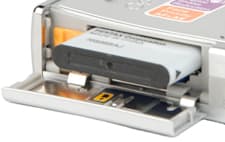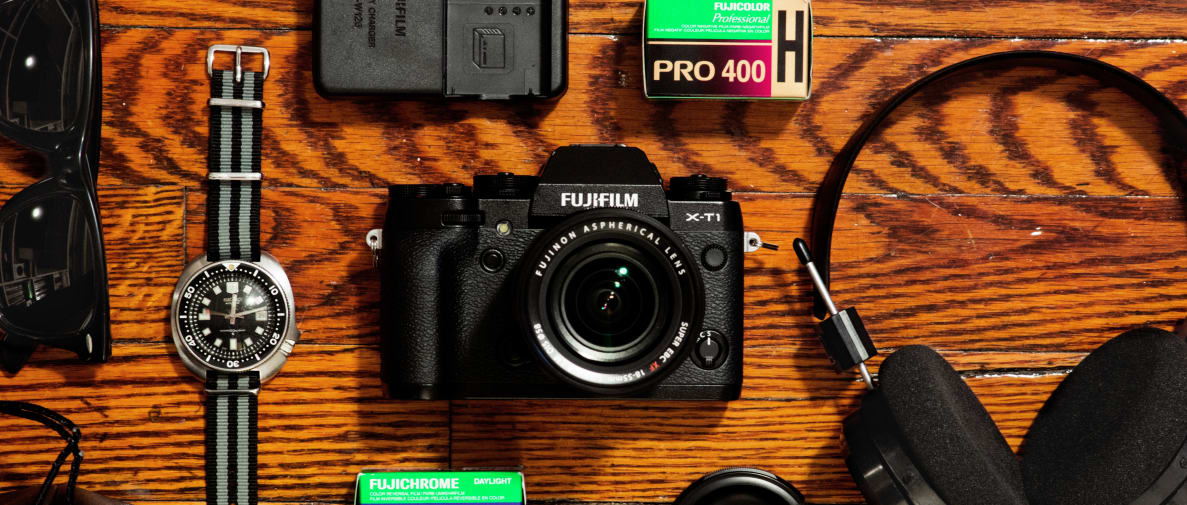Pros
Cons
This year, seemingly out of nowhere, comes Fujifilm’s new X-T1 (MSRP $1,299.95 body-only). Breaking from the rangefinder style that the company wholeheartedly embraced with the X-Pro1 and X-E1, the X-T1 is a classic SLR-style mirrorless camera based on the same excellent, growing system of lenses.
Built with the same exquisite attention-to-detail that Fuji’s other Japanese-manufactured cameras feature, this new body outshines its stablemates in a number of ways. But, the X-T1 is entering enemy territory. Our 2013 camera of the year, Olympus's OM-D E-M1 set a high water mark for a speedy, modern mirrorless camera. Making the segment even tougher to compete in, Sony's A7 and A7R both bring a full-frame sensor in a compact body.
But, Fujifilm hasn't sent the X-T1 into battle without an arsenal of its own. Featuring weather sealing, a high-resolution EVF, and a great control scheme, the X-T1 looks like it’s got the right stuff to go up against that tough competition in the mid-$1,000 price range.
Design & Handling
The most ergonomic X Mount camera to date
Taking inspiration from Fujifilm's legacy SLR cameras, the X-T1 puts even more emphasis on dedicated dials than ever before. Whereas the X-Pro1 and X-E1 both featured exposure compensation and shutter speed dials, the X-T1 adds an ISO dial for good measure. What you won’t find is a mode dial, signaling this camera’s seriousness immediately. But, don't worry, there are auto settings on many of these controls.
{{ photo_gallery "tour" }}
This camera benefits from its SLR-style design, hitting the sweet spot between heft and size. It's a bit smaller than Fujifilm's other two high-end X Mount bodies, and it's an incredibly tidy package on the whole.
Most of the controls you’ll need are within reach of the fingers on your right hand. While shooting, you can use your left hand as you choose, for example to support the lens, operate the aperture ring, tilt the screen, or to quickly adjust the ISO sensitivity. While it’s hardly a one-handed camera, we think that the controls are laid out incredibly well and that this is the closest to a true film-style manual operation you can get without busting out your vintage SLR.
{{ photo_gallery "design" }}
Even though it may be smaller in stature, the X-T1's curved front grip makes it the easiest-to-hold of the X-Mount siblings. The front grip better counterbalances use of the rear controls for operation, especially the exposure compensation dial. While we prefer the overall design of the Olympus OM-D E-M1 from a sheer usability standpoint, the X-T1 is a more pleasing mix of retro design cues with modern concessions to comfort.
New to the X-Mount cameras is the X-T1's front control dial. This complicates the dedicated control scheme a bit, with the rear dial coming in handy when changing settings in the handy Q menu (it is also used to change the aperture when you’ve mounted a lens without an aperture control ring), and the front dial is good for quickly shifting shutter speed to settings not available on the top selector (when you’re not in auto mode).

While it’s easy to gush about yet another precision-built Fujifilm camera body, there are still a few quirks that can’t be fixed with firmware updates. We found the dedicated SD card flap on the side of the camera a wonderful addition, but one that was all too easily opened. The flap doesn’t close with a reassuring click either, and all it takes is a touch or a brush of your palm to accidentally spring it wide open.
We can't help but wish that the dedicated ISO and shutter speed dials had different locking mechanisms on them. The dial feel itself is fine, but both dials use a similar locking button in different ways. The ISO dial is always locked, and you need to press down the center button in order to change at all times. The shutter speed dial, on the other hand, stays locked only when in the red Auto setting. Once you unlock the dial from that position, the wheel turns freely. These might seem like little issues, we would have greatly preferred a lock you can toggle, like the mode dial on the OM-D E-M1 or the Pentax K-3.
We also had issues with the stock EVF eyepiece. Even though it’s a nice design callback to the unique circular optical viewfinder on the Fujica ST901 SLR, the X-T1's shallow rubber cup does little to shield your eye from the sun. Hopefully Fujifilm or a third party will release a deeper eyepiece to remedy this irksome usability problem.
Finally, we have to gripe about the rear d-pad. It's just way too deeply embedded in the X-T1's body, especially where a nice bit of textured rubber curves around to cover the back grip. While this design choice might make accidental input less likely, it makes intentional input frustrating as a side effect.
Features
An innovative set of tough-to-beat features
Fujifilm’s newfound reputation for great cameras just keeps getting better. The Fuij-exclusive X-Trans APS-C sized sensor (with on-chip phase detection pixels), film simulation modes that make you weak in the knees, and a terrific lens lineup all help make these cameras stand out. The X-T1 ups the ante even a little bit more. Not only is the design and control scheme better than past cameras, the innovative little touches show Fuji's not resting on their laurels. Fujifilm knows the camera world is changing quickly, and it’s digging in by giving enthusiasts exactly what they want.
The feature that immediately impresses is the X-T1’s ginormous electronic viewfinder. Built around a high-resolution OLED 2.36M-dot panel with three optical elements in front (making for a huge, 0.77x display), Fujifilm has really taken the software powering it to the next level. Turn the camera from landscape to portrait, and the information in the finder rotates, too. Our favorite new EVF trick is what Fujifilm calls Dual mode. When manual focusing, you get picture-in-picture, with the full, uncropped image in the larger box, a smaller zoomed-in version with your choice of Digital Split Image or peaking applied. Not to mention that the huge panel manages to also keep the histogram and all other critical shooting information displayed at the same time.
The only thing that’s left out of the X-T1 is a pop-up flash, something that most of the other Fujifilm X-Mount cameras have come with built-in. Instead, Fujifilm bundles a small flash unit that can mount on the camera’s hot shoe. You'll have to carry it around, but at least it's an option.
A brand-new feature to the Fujifilm mirrorless lineup is weather sealing. Like the competing Sony A7 siblings, and Olympus's OM-D E-M1, the X-T1 is designed to handle a bit of moisture. While you can't submerge the camera, and we'd be extremely hesitant to run it under a faucet, it's a nice little bonus to have. Unfortunately, it's a completely useless feature until Fujifilm releases lenses with a corresponding seal on the bayonet mount (three lenses are on the roadmap as of this writing). As it stands, if you take the X-T1 and its kit lens out of doors in a downpour, well, hope you're willing to shell out for a new camera, pal.
Performance
A kick-butt still camera
While the X-T1 isn't the most technically impressive camera we've seen, it more than holds its own when we compare it to other large-sensor interchangeable cameras on the market. Like many of the Fujifilm cameras of late, the X-T1 might impress on the spec sheet, but where it really wins your heart is out in the field. While this might drive pixel-peeping, early-adopting, overly demanding fanboys out of their skulls, the truth of the matter is that all the camera technology in the world is worth nothing if it can't come together to make a beautiful image.
One of our favorite color modes, Pro Neg Standard, was the most accurate of all the available color film simulation modes. While it doesn't pop as much as the Pro Neg High mode, it offers up the least distorted profile. But, who are we kidding? This camera makes incredible JPEGs and you should play with all the color modes to find which ones you like the best. Even if you're not a RAW shooter, you'll get excellent results.
{{ photo_gallery "sample_photo" }}
Burst speed is an area where the X-T1 caught us off guard and really impressed. Shooting JPEGs, the X-T1 managed to crank out a blistering 8.67 fps—more than a half frame more than Fujifilm's official rating. If you are shooting RAW+JPEG, you'll notice that the buffer doesn't hold as many shots, since there's more data involved, causing a logjam in the camera's cache. That said, if you stick to JPEGs, you'll get a little more than 30 shots off before the quick frame rate slows down to a little less than 1 fps.
In our video testing, the X-T1 did far worse than the competition. Not only do you have to deal with really bad pixel binning due to the Fujifilm-only X-Trans sensor technology, the sensitivity of the sensor just did this camera no favors, either. The ugly moiré patterns we saw on our sharpness charts turned parts of the test footage green and yellow with false color. Detail wasn't completely obliterated, but we noticed in our sample video that the motion was less than stellar and the whole thing looked too soft. A hybrid camera the X-T1 isn't. Ugly though the footage may be, at least Fujifilm offers shooters a 1080/60p top shooting mode–something Olympus famously hasn't managed to pull off quite yet.
Fujifilm made a big to-do regarding the X-T1's autofocus speed, citing its 0.08ms time as the world's fastest. Well, that's not really the entire story. Fujifilm's claims were made with what they call Pre-AF on, meaning the camera is constantly refocusing on whichever AF point is selected (which, will undoubtedly drain your battery very quickly). All of this aside, even if the X-T1 isn't the world's fastest focusing camera (a title that seems to change hands almost monthly), it's pretty darn quick and we had no complaints about the overall speed of operation.
For more about how the X-T1 performed in our lab tests, visit our Science Page.
Conclusion
Despite stiff competition, the X-T1 still manages to stand out.
Even though the X-T1 breaks with Fujifilm’s “poor-man’s Leica” image given the company's past adherence to rangefinder-style designs, this is one hot camera with pure Fuji blood flowing through its digital veins. It has the raw sex appeal and performance chops to entice enthusiasts who didn’t find the X-Pro1 or X-E2 designs to their liking.

Specs are one thing, and the X-T1 undoubtedly delivers what you'd expect, adding surprise and delight to the ownership package. Not only is the X Mount system burgeoning with well-priced premium primes (say that ten times fast), you also get the unique X-Trans sensor technology, and Fujifilm's authentically lovely film simulation modes. Then there's the now-famous Fujifilm support. Fujifilm has taken customer listening to the next level, making sure that owners get timely firmware updates with useful feature additions and often transformative performance improvements. Fujifilm keeps improving existing models through downloads in ways that blow the competition out of the water.
If the X-T1 has started to sway your system camera allegiance, we have to recommend that you pick up the kit option. Unlike many other kit lenses on the market today, the 18-55mm f/2.8-4 is faster than average, and nicely sharp for much of the zoom range. There's a reason this lens on its own sells for almost $700—it's fantastic.
While many will compare the X-T1 most directly to the Sony A7, we think this camera has something that the Sony option, though technically proficient, lacks—charm. The X-T1 doesn’t need to be the fastest at anything to be great, it just needs to appeal to the senses and take excellent photos, both of which it does superbly. We prefer the Olympus OM-D E-M1 for its rugged design and responsiveness but, on sheer personality, the X-T1 still wins us over.
Fujifilm's incredible history of high-quality film stock lives on through its X Mount system, and we're excited to see more of where the great X-T1 came from.
By the Numbers
The Fujifilm X-T1, while a looker in the metal, is also a solid performer in most respects. Even though this is an instrument built for creating art, there's no doubt that, unlike the Leica M, it's actually a high-performing, modern camera through and through.
Color and White Balance
The signature color modes that the X-T1 offers closely simulate classic Fujifilm film stocks from the 35mm glory days. Like other Fujifilm cameras, the most accurate mode was Pro Neg Standard, with a ∆C00 uncorrected mean of 1.99 and a saturation of 95.0%.
While this isn't too far from the ideal in some aspects, but if you're looking for precision color accuracy, this isn't the camera for you. The film simulation modes work so well, that, many might prefer to shoot straight to JPEG than to automatically switch to RAW.
White balance was about average. Few manufacturers have matched some of Panasonic's recent cameras in terms of sheer clinical accuracy. While custom settings were about as good as anything we've tested, the ever-difficult incandescent white balance in auto mode was off by as much as -2104 degrees Kelvin.
Dynamic Range
The X-T1, like other high-end Fujifilm cameras, uses the unique X-Trans color filter configuration. This non-standard feature is supposed to make for more lifelike colors, but it also throws a bit of a wrench into our normal dynamic range examination. After analyzing the RAW photos we took with the X-T1, abnormally low read noise in the shadows leads us to believe that there's some tampering with the shadow data, before the RAW file is written to the card. That means that some deep shadow data is can come out a little bit clipped, so you might lose some detail in RAW if you're underexposing.
As far as we can tell from the data that we collected, the X-T1 is good for between 11 and 12 stops of dynamic range in base ISO (ISO 200).
Resolution
We tested the X-T1 with its kit option, Fujifilm's XF Zoom 18-55mm f/2.8-4. We were generally pleased with the performance of this lens, at all but full telephoto. We noticed that, even though at full wide and midway through the zoom range, the lens is great, it gets noticeably softer at 55mm, even when stopped down to f/5.6.
Video
Fujifilm's video problem hasn't gotten any better with the faster processing in the X-T1. We still saw some really nasty moiré on our video sharpness chart, likely due to the camera's unique X-Trans color filter and the camera's pixel binning algorithm. In our standard still-life motion test, we noticed the overall picture looked soft, as we've seen from other Fujifilm X-Trans cameras.
That said, the ugly false color only diminished visible detail on the chart by a bit. In our standard bright light test, we measured 600 lw/ph horizontal and 615 lw/ph vertical. In low light, the X-T1 scored 550 lw/ph horizontal and 575 lw/ph vertical. Where the X-T1 really disappointed was in our low light sensitivity test, requiring 23 lux to create a picture at 50 IRE.
Noise Reduction
The X-T1's noise profiles keep noise under control with an iron fist, with just enough adjustment in-camera to tune things to your liking. When the default setting is turned on (it's marked "0" in the X-T1's menus), the color noise percentage never crosses the 2% threshold, even at 256,000. Additionally, Fujifilm's three top high ISOs, 12,800, 25,600, and 512,600 are all JPEG-only, which would be a buzzkill if they weren't all so noisy and useless. Fujifilm has gone so far as to hide 512,600 from users by putting it in a custom menu for the ISO dial. Our recommendation for Auto ISO users is to cap the available range to a max of 1600, using 3200 as your emergency high ISO option.
Meet the tester
Brendan is originally from California. Prior to writing for Reviewed.com, he graduated from UC Santa Cruz and did IT support and wrote for a technology blog in the mythical Silicon Valley. Brendan enjoys history, Marx Brothers films, Vietnamese food, cars, and laughing loudly.
Checking our work.
Our team is here to help you buy the best stuff and love what you own. Our writers, editors, and experts obsess over the products we cover to make sure you're confident and satisfied. Have a different opinion about something we recommend? Email us and we'll compare notes.
Shoot us an email


